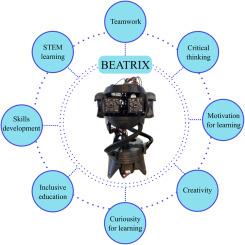BEATRIX:用于机器人教学和研究的开源仿人头部平台
IF 2.1
Q3 ENGINEERING, ELECTRICAL & ELECTRONIC
引用次数: 0
摘要
本文介绍的 BEATRIX 是一种新型机器人头,旨在弥补大学机器人学领域理论知识与实践经验之间的差距。BEATRIX 机器人包括一个由类似颈部的机构驱动的头部、三个步进电机、两个摄像头和两个麦克风,用于从环境中获取视觉和听觉信息。该机器人可与任何外部计算机连接,用于设计和实施人机交互应用的算法。本科生和硕士生已经成功使用了所提出的机器人平台,执行了人脸检测和跟踪、声音检测和跟踪、机器人控制和图形用户界面等任务。本文包括所有机器人组件清单、组装说明以及所有 CAD 和软件文件的链接,以便于复制和进一步探索。机器人的设计以及视觉和听觉传感器的集成,使得开发引人入胜的教育教程和机器人实验成为可能,从而增强了机器人技术的教学和学习体验。本文章由计算机程序翻译,如有差异,请以英文原文为准。

BEATRIX: An open source humanoid head platform for robotics teaching and research
This paper introduces BEATRIX, a novel robotic head designed to bridge the gap between theoretical knowledge and practical experience in the field of robotics at universities. The BEATRIX robot comprises a head actuated by a neck-like mechanism with three stepper motors, two cameras and two microphones for acquisition of visual and audio information from the environment. The robot can be connected to any external computer for the design and implementation of algorithms for applications in human–robot interaction. The proposed robotic platform has been used successfully with undergraduate and master students implementing tasks such as face detection and tracking, sound detection and tracking, robot control and graphical user interfaces. This paper includes lists of all the robot components, assembly instructions, and links to all CAD and software files, facilitating replication and further exploration. The robot design and integration of visual and audio sensors enables the development of engaging educational tutorials and robot experiments, enhancing the teaching and learning experience in robotics.
求助全文
通过发布文献求助,成功后即可免费获取论文全文。
去求助
来源期刊

HardwareX
Engineering-Industrial and Manufacturing Engineering
CiteScore
4.10
自引率
18.20%
发文量
124
审稿时长
24 weeks
期刊介绍:
HardwareX is an open access journal established to promote free and open source designing, building and customizing of scientific infrastructure (hardware). HardwareX aims to recognize researchers for the time and effort in developing scientific infrastructure while providing end-users with sufficient information to replicate and validate the advances presented. HardwareX is open to input from all scientific, technological and medical disciplines. Scientific infrastructure will be interpreted in the broadest sense. Including hardware modifications to existing infrastructure, sensors and tools that perform measurements and other functions outside of the traditional lab setting (such as wearables, air/water quality sensors, and low cost alternatives to existing tools), and the creation of wholly new tools for either standard or novel laboratory tasks. Authors are encouraged to submit hardware developments that address all aspects of science, not only the final measurement, for example, enhancements in sample preparation and handling, user safety, and quality control. The use of distributed digital manufacturing strategies (e.g. 3-D printing) is encouraged. All designs must be submitted under an open hardware license.
 求助内容:
求助内容: 应助结果提醒方式:
应助结果提醒方式:


